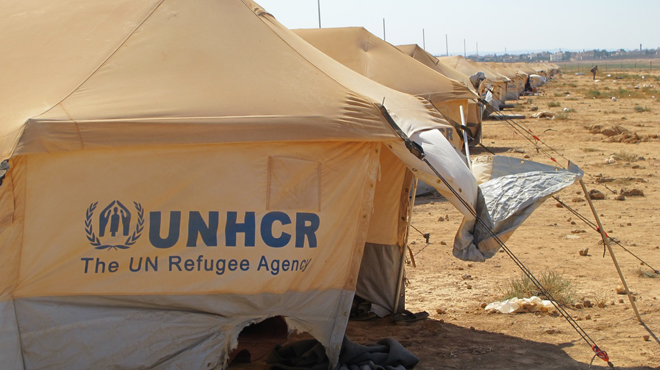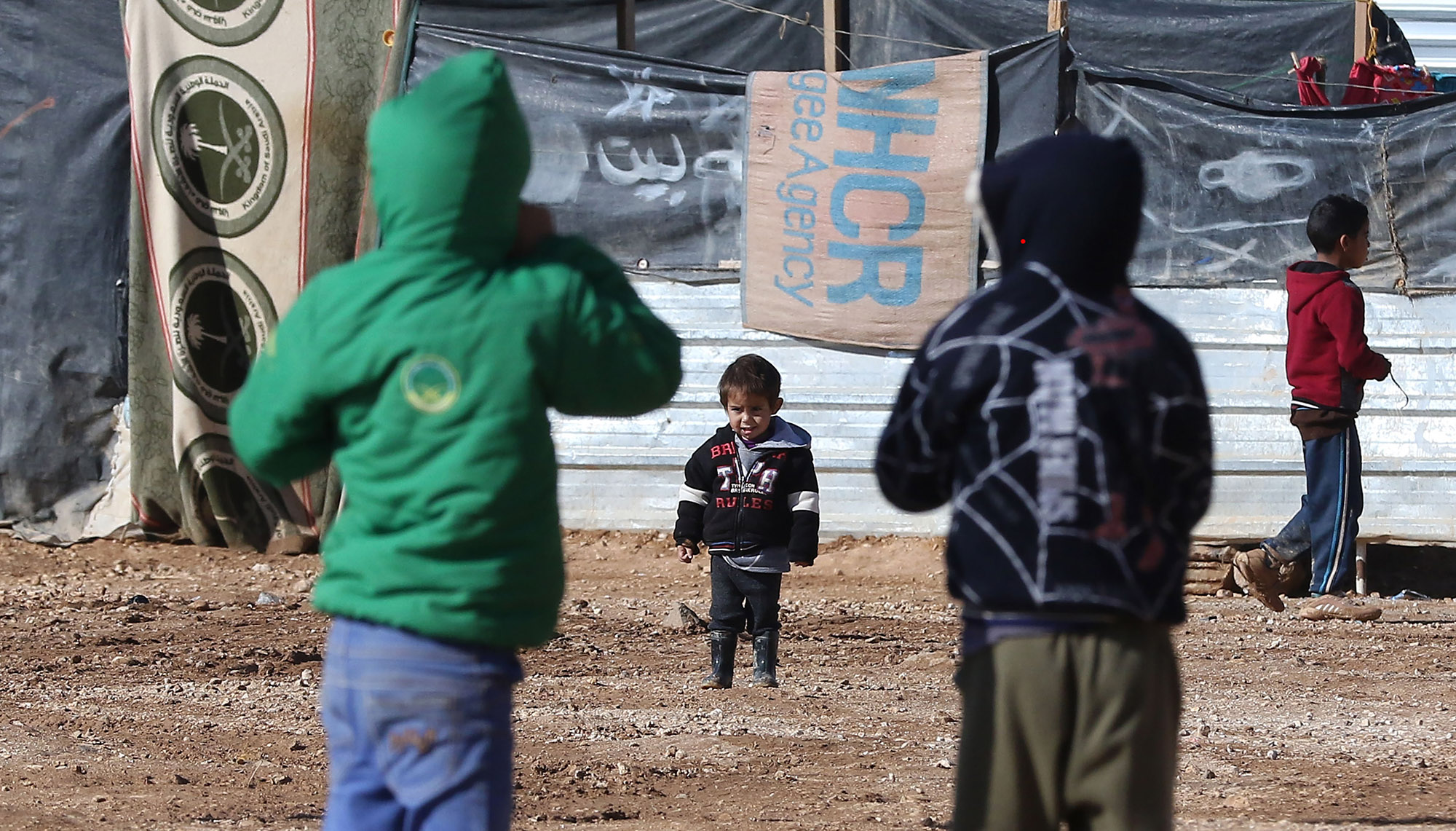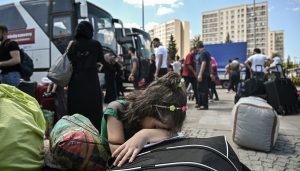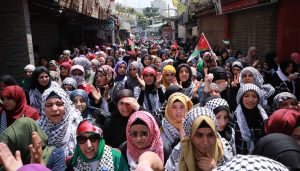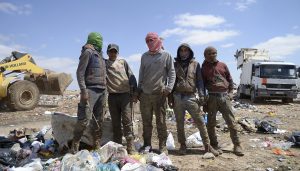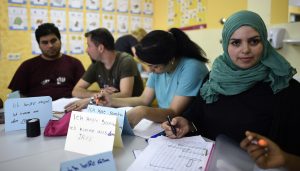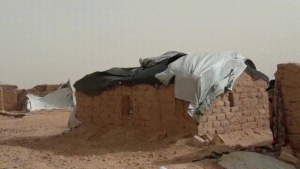Originally published on SMEX
By Mike Pizzi*
During the damp months of the Jordanian winter, I was compelled to make a few trips up to the Zaatari refugee camp in Mafraq to try and get a sense of whether Internet access was even on the radar screen there. As I waited around for results from my survey to precipitate into my inbox, I wanted to know if those Syrian refugees in the direst straits were accessing the Internet with any regularity. If people were online in Zaatari, I figured, Syrian refugees around Jordan were bound to be in even greater numbers.
Zaatari is the first and largest Syrian refugee camp in Jordan, home to well over 100,000 refugees (the UN has the population at over 200,000 but many people have snuck out). Aid workers and Syrian friends living in Amman had provided me with conflicting information on the topic of Zaatari internet use. There were those who pointed out that no one living in a desolate field of tents and prefab structures would bother investing in Internet access, and yet others had confirmed contact over social media with friends and family in the camp. I’d heard rumors about phantom Internet cafes run out of uninhabited tents, but I’d also heard that computers were impossible to come by in Zaatari, not to mention a security liability. I’d even been told that, given the politically charged nature of the camp and the Syrian experience with Internet surveillance back home, people would be fearful of discussing their online activity with me, and yet Syrian contacts in Amman had no such inhibitions.
It became clear to me that, in fact, no one had any idea if Internet use in Zaatari was widespread except for the residents themselves. So I wanted to talk to them.
Surveying the camp
Granted, my sample size at Zaatari has only been around 40 men so far, but I wouldn’t have expected all but two of them to access the Internet daily (those two were also the oldest). While I concentrated my efforts on vendors in the market area who sold cell phones and electronics, the demographic I considered most likely to be using the Internet, these men consistently estimated that 30-40% of people in Zaatari used the Internet daily like they did.
Given how little most people fled Syria with – many were forced to make the dangerous journey by foot and pass into Jordan at unofficial rebel-held crossings – and adding to that how there isn’t even electricity available in housing units, you might be wondering: how?
The answer is fairly complicated. Many people brought laptops and cell phones with them, a logical decision given that these are valuable and portable, but it wasn’t a sure bet they’d be able to access the Internet with them from Zaatari. As it turns out, however, if a refugee did bring an ICT device from Syria, access to the Internet is merely a matter of securing a Jordanian SIM card, for a cell, or a USB mobile Internet stick (they call them “dongles” here), for a laptop. Fortunately for those who traveled light, i.e. without an Internet-ready device of any sort, Zaatari offers some options on the Internet access front.
 The whole business of transporting electronics and ICTs into the camp is shrouded in mystery – and a fair amount of government indifference – but most of these goods are actually not supposed to be there. Zaatari’s black market, called “Little Damascus” by some, is a several kilometer stretch of road lined with busy kiosks on both sides of the street. The market sells everything from televisions and satellite dishes to shisha and Syrian shawarma. Over the two months that passed between my first and second surveys of the camp, maybe 75 new kiosks had popped up, and there are even real estate brokers who’ve taken to selling empty kiosks to aspiring small business owners – handwritten signs, each reading “For Sale” and bearing a Jordanian cell phone number, cover dozens of these shacks. On my first visit to the camp, I tallied over 70 kiosks advertising cell phones, cell phone credit, or miscellaneous electronics on the main drag alone. There’s even a guy selling broken-down washing machines and dryers – what these could be used for I have no idea. Apparently this type of market is fairly typical in refugee camps like Zaatari, but I had never seen anything like it.
The whole business of transporting electronics and ICTs into the camp is shrouded in mystery – and a fair amount of government indifference – but most of these goods are actually not supposed to be there. Zaatari’s black market, called “Little Damascus” by some, is a several kilometer stretch of road lined with busy kiosks on both sides of the street. The market sells everything from televisions and satellite dishes to shisha and Syrian shawarma. Over the two months that passed between my first and second surveys of the camp, maybe 75 new kiosks had popped up, and there are even real estate brokers who’ve taken to selling empty kiosks to aspiring small business owners – handwritten signs, each reading “For Sale” and bearing a Jordanian cell phone number, cover dozens of these shacks. On my first visit to the camp, I tallied over 70 kiosks advertising cell phones, cell phone credit, or miscellaneous electronics on the main drag alone. There’s even a guy selling broken-down washing machines and dryers – what these could be used for I have no idea. Apparently this type of market is fairly typical in refugee camps like Zaatari, but I had never seen anything like it.
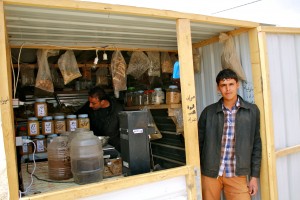 Vendors are pretty forthcoming about leaving the camp or working with Jordanian nationals outside Zaatari to coordinate the import of black market goods into the camp. The men explained to me that costs for Internet access via cell phone data are a few dinars higher for those in Zaatari than for regular citizens, as layers of Jordanian middlemen take their cuts. Even so, costs are fairly low if you’re just using Facebook and email – some people who accessed the Internet on their phones every day said they only spent 4 JD/month ($6).
Vendors are pretty forthcoming about leaving the camp or working with Jordanian nationals outside Zaatari to coordinate the import of black market goods into the camp. The men explained to me that costs for Internet access via cell phone data are a few dinars higher for those in Zaatari than for regular citizens, as layers of Jordanian middlemen take their cuts. Even so, costs are fairly low if you’re just using Facebook and email – some people who accessed the Internet on their phones every day said they only spent 4 JD/month ($6).
Even with the camp’s fully functioning black market, however, certain products are difficult to acquire – laptops, in particular. One vendor, Mahmoud, detailed his laptop importing service, explaining how he traveled into Amman to pick one up whenever a camp resident requested one and offered to pay the 300-500 JD ($420-700) up front, but admitted that he’d only done that trip a few times. Everyone I talked to who used a computer to access the Internet said that they had brought it with them from Syria.
Mobile access
Most people do not rely on computers for Internet access in Zaatari, as is the case anywhere in the world. Everyone I surveyed who owned a laptop also accessed the Internet via their mobile phone, and many did so only on the latter. Data service is technically available, but the biggest frustration articulated by these men was that the Zain and Umniah networks are unusably slow for most of the day. Hundreds of thousands of Syrians have arrived in northern Jordan out of nowhere over the last year and a half and existing cell infrastructure is unable to accommodate them. Common wisdom holds that Zain has the best plan at night, whereas Umniah is better during the day. Syriatel service, available on a certain hill in the camp (Mafraq is just miles from the Syrian border), is cheapest for communicating with family back home. In other words, some residents have three separate SIM cards that they pop into their mobile phones depending on when they’re calling or using data.
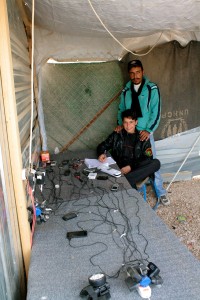 An added complication to this whole scenario is that residents are not provided with electricity, only a gas canister designed for cooking and limited heating. Unsurprisingly, people have found ways to work around the energy restrictions. In the market, some vendors have rewired the public electric grid cables and diverted them to kiosks in order to provide charging service for personal electronics. Others use a contraption that converts the allotted gas provision into usable electricity. Residents can drop their cell phones off at these stations along with 5 Syrian pounds (although I was quoted at 50) and then pick them up fully charged. The same can be done with laptops.
An added complication to this whole scenario is that residents are not provided with electricity, only a gas canister designed for cooking and limited heating. Unsurprisingly, people have found ways to work around the energy restrictions. In the market, some vendors have rewired the public electric grid cables and diverted them to kiosks in order to provide charging service for personal electronics. Others use a contraption that converts the allotted gas provision into usable electricity. Residents can drop their cell phones off at these stations along with 5 Syrian pounds (although I was quoted at 50) and then pick them up fully charged. The same can be done with laptops.
Because of the clogged data networks, Skyping or streaming YouTube clips is usually out of the question. There are nightly windows when use of these platforms is possible, but overall, residents are frustrated by the insufficient data networks. Internet is slow, and no one is satisfied with it.
Internet Cafes?
“We’re used to the Internet,” a vendor from Dara’a told me during my second visit, “why can’t the UN provide an Internet café?” I don’t think he expected this request to be realized anytime soon, but I also don’t think it should be scoffed at. The UNHCR is stretched very thin – to date, only 55% of its requested funding for the Syrian crisis has been met – but there is overwhelming demand for Internet access.
Even if public Internet terminals are not practical for aid groups to provide, Zaatari’s private sector could otherwise offer this service – were it not for potential government interference. Mahmoud, the first vendor from Dara’a, has an ambition to start an Internet café in the roughly 8’ by 10’ annex attached to his cell phone repair kiosk. He says that the Jordanian mukhabarat, or secret police, would likely shut it down, however, out of concerns that people might use the Internet to organize unrest and incite violence in the camp. “I only need 10 computers, maybe, but I’d have to pay for them up front,” he told me, pointing out that this investment would be a huge risk given that the café might get shut down immediately.
While the extent of Internet proliferation in Zaatari deserves more research, I can at least confirm that Internet access is available to those in Zaatari who seek it out. There have been a few successful Internet access initiatives targeted at longer term refugees, and mobile phones have of course been sold in refugee camps for years now, but Zaatari is interesting in that camp residents who have just arrived in country are immediately piecing together the requisite infrastructure without NGO or UN assistance. They are establishing Internet connectivity for themselves, despite the considerable obstacles and costs. Maybe there’s something unique about the Syrian case, or maybe this will be the trend as the digital age comes to fruition for even the most disadvantaged and transient demographics. These are obviously big questions that I can’t begin to answer.
In my next post, I’ll present my findings on what the computer literate among Za’atari’s residents are actually doing on the Internet.
*Mike Pizzi is on a Fulbright research grant to Jordan, where he is studying Internet access and social media use in refugee communities. He is conducting a survey and a series of interviews about Internet use patterns among urban Syrian, Iraqi, and Palestinian refugees in Jordan – and he’ll contribute his findings to SMEX along the way. He can be reached at [email protected].
